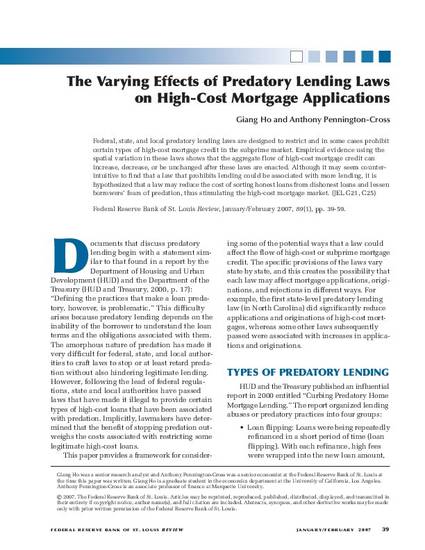
Article
The Varying Effects of Predatory Lending Laws on High-Cost Mortgage Applications
Federal Reserve Bank of St. Louis Review
Document Type
Article
Language
eng
Format of Original
22 p.
Publication Date
1-1-2007
Publisher
Federal Reserve Bank of Saint Louis
Disciplines
Abstract
Federal, state, and local predatory lending laws are designed to restrict and in some cases prohibit certain types of high-cost mortgage credit in the subprime market. Empirical evidence using the spatial variation in these laws shows that the aggregate flow of high-cost mortgage credit can increase, decrease, or be unchanged after these laws are enacted. Although it may seem counterintuitive to find that a law that prohibits lending could be associated with more lending, it is hypothesized that a law may reduce the cost of sorting honest loans from dishonest loans and lessen borrowers’ fears of predation, thus stimulating the high-cost mortgage market.
Citation Information
Giang Ho and Anthony Pennington-Cross. "The Varying Effects of Predatory Lending Laws on High-Cost Mortgage Applications" Federal Reserve Bank of St. Louis Review (2007) ISSN: 0014-9187 Available at: http://works.bepress.com/anthony_pennington_cross/9/

Published version. Federal Reserve Bank of St. Louis Review, Vol. 89, No. 1 (January/February 2007): 39-60. © 2017 Federal Reserve Bank of Saint Louis. Used with permission.
Originally published in Federal Reserve Bank of St. Louis Review. © 2007 by the Federal Reserve Bank of St. Louis. All views expressed herein are those of the author(s) and not necessarily those of the Federal Reserve Bank of St. Louis or the Federal Reserve System.